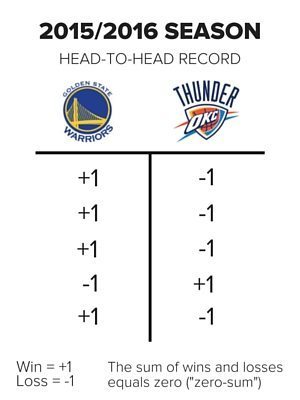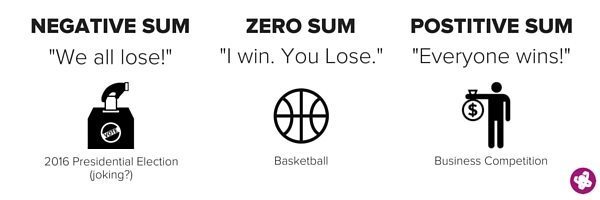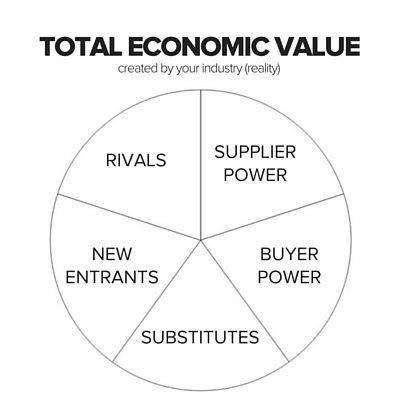Several weeks ago I wrote an article about strategic positioning: the art of creating a sustainable competitive advantage for your medical practice.
But I put the cart before the horse.
Before you can develop a competitive advantage for your medical practice, first you need to unlearn everything you know about competition.
Sport, history, love, war…
Forget everything you know about competing to win.
It won’t help you where you’re going.
In this article, we’ll uncover the truth about competition and why antiquity’s version of head-to-head competition doesn’t serve us well in the business world- at all.
Along the way, we’ll draw inspiration from strategy experts like Michael Porter, Rita Gunther McGrath, and Joanna Magretta, and we’ll explore how each of their philosophies about competition work in the medical world.
When you’re finished, you’ll understand the true nature of competition in medicine so you can develop a competitive advantage in your market and win more patients.
Consider this Competition 101.
Let’s get started.
What Is Competition?
Competition is a game of one-upmanship, of dominating rivals, of celebrating victory while your opponent suffers the pangs of defeat, right?
Sure, if you’re playing basketball or chess, or if you and your bestie are both vying for the love of the same person.
In game theory, they call this zero-sum competition: competition in which one person’s gain is another person’s loss.

But unlike basketball, chess, or Social Darwinism, competition in the business world can and should be a positive-sum game: there’s more than one way to win when you compete to create superior value for your patients.
In positive-sum competition, success requires that you be unique in how you deliver value, not the best. And it’s the only way to gain a competitive advantage.

So where does your medical practice fit in: positive-sum or zero-sum?
And why does it matter?
Before you can actually develop or assess your practice’s business strategy, first you need to understand the true nature of competition and how it works for your medical practice.
More importantly, if you ever wish to develop a successful strategy for outperforming your competitors, you’ll need to understand why your traditional view of competition (zero-sum/winner-takes-all) is toxically unhealthy for your practice.
Be The Best: Zero-Sum Competition
So why, then, is it such a bad thing to want to crush your competitors in a race to be the best? Don’t you want your competitors to suffer losses while you enjoy victories?
First, since every industry has different customers with different needs, there is no such thing as the best in business. It’s a fallacy. Stop chasing it.
Think about it:
Who’s the best home improvement store: Home Depot, Menard’s or Lowe’s?

It depends on whom you ask, right?
If you’re a homeowner who prefers luxury, and price isn’t an issue, then Menard’s is the best; if you’re a general contractor who prefers scope of materials at reasonable prices, then Home Depot is the best; and if you’re a novice do-it-yourselfer who wants to hang window treatments in your living room, then Lowe’s is the best.

All three retailers enjoy huge shares of the home improvement market.
Serving different customer segments doesn’t start and stop with home improvement. In any industry, health care included, multiple businesses can thrive by competing differently rather than competing to be the best.
Second, competing in a head-to-head, win-loss, zero-sum competition to one-up your competitors leads to commoditization.
Or, as Joan Magretta says in her book Understanding Michael Porter, “If rivals pursue the ‘one best way’ to compete, they will find themselves on a collision course.”

A collision course looks something like this:
- Everyone chases the same customer segments.
- Everyone follows the same best practices.
- Everyone copies each other’s features.
- Everyone purchases the same devices.
- Everyone takes the same steps to deliver value.
- Everyone hires the same type of talent.
- Everyone outsources to the same companies.
- Everyone partners with the same vendors and suppliers.
- Everyone…. Everyone.
So, while you may think that adding a new service or improving an existing one will make you better than your competitors in head-head-competition, it’s only a matter of time before they add or improve the same service.
The result?
Everyone becomes undifferentiated while profits erode and competitors compete in a winless battle over price- no one gains a competitive advantage. Not to mention that the customers’ choice erodes as companies converge on their offerings.
Commoditization, above all, is why zero-sum competition will lead you astray; worse, homogeneity in health care hurts the patient the most. Because, as Magretta also states, “when choice is limited, value is often destroyed.”
Instead, your medical practice should compete to be unique; instead of playing the same game as everyone else, start your own game!

You can try to one-up your direct rivals, or you can create your own game. Like this cat? image source
Be Unique: Positive-Sum Competition
Imagine telling Kobe Bryant that both opponents in a basketball game could win.
Hah!
…Mamba. Out.

But in the business world, since there are multiple ways to compete for the same audience, and since you can create value in any number of different ways, more than one business can win without doing so at the expense of someone else.
Or, as Michael Porter champions, positive-sum competition means choosing a path different from your competitors. Rather than competing to be the best, you’re competing to be unique.
And, as Magretta adds, in positive-sum competition “companies pursue distinctive ways of competing aimed at serving different sets of needs and customers. The focus, in other words, is on creating superior value for the chosen customers, not on imitating and matching rivals.” [Emphasis mine]
The result?
Positive-sum competition increases value rather than divides it, and everyone benefits, from the business to the customer; this is the true essence of competition in business. And it’s exactly how you should think about competition within the medical industry.
For example, when faced with intense competition in the bay area, Studio Dental decided to play by their own rules: they carved out a niche by taking the show on the road, and now they serve the tech industries top executives… at lunch time.

Doesn’t positive-sum competition sound like a lot more fun than wins and losses?
To be clear: positive-sum competition wasn’t born out of some democratic, pacifist desire to avoid competition with industry rivals- quite the opposite.
Rather, it’s a more strategic way of viewing competition.
It’s a way of choosing a different way to win by using a different set of activities than your competitors when delivering value.
Finally, it’s a way to outperform your competitors consistently by strategically positioning your service as unique.
Let’s revisit our home improvement retailer example (I’ll give you a health care example in the next section):
Home Depot, Menard’s, and Lowe’s all sell the same types of products and services. However, each chooses to target a different segment of home improvement customers who have different wants and needs.
To top it off, they organize their activities (from the way they lay out their store to the brands they put on the shelves) differently from one another to provide superior value to their respective customer segment, no one else’s.
While you might think that all three compete to be the best, they actually compete to be unique.
Idea in Practice: Health Care (Non-Elective vs. Elective)
In his book, Redefining Health Care, Michael Porter juxtaposes the current zero-sum competitive landscape in health care (non-elective) with his proposed positive-sum alternative.
More adamantly, Porter goes a step further and blames the failures of the entire health care system (non-elective) directly on competition. Not on a lack of competition, but on the wrong type of competition: zero-sum.
Zero-Sum in Health Care

According to Porter, rather than compete on delivering unique value—measured by a physician’s individual results—the entire health care system (non-elective), from the health plan to the provider to the employer to the patient, competes against each other for revenue.
The result?
A system-wide insulation from competing on patient value and results.
Or, in other words, a complete lack of accountability and transparency regarding patient outcomes throughout the entire cycle of care.
Instead, as Porter explains, the health care system (non-elective) competes amongst health plans, hospitals and networks to be the best. And since patients don’t have a choice (e.g. limited coverage, health plan restrictions, out of network fees, vertically integrated health plans and provider networks), there’s little we can do to affect change.
Health plans compete head-to-head to add healthy subscribers: Zero-sum.
Providers compete with each other to be in health plans by mass discounting to large employers: Zero-sum.
Providers and payers compete to shift costs to each other, shifting and shifting back and forth: Zero-sum.
And so on…
In the end, hospitals’, providers’, and physicians’ ability to meet the unique needs of different patient segments erode; costs increase across the board, and the patient suffers the most.
All because… yep, zero-sum competition.
Thinking Allowed: Competition in non-elective health care is a zero-sum game where everyone involved tries to one-up each other rather than add unique value to the patients, primarily because they don’t need to be differentiated to make money still. Funny enough, studies show that increasing patient quality actually increases efficiency resulting in reduced costs throughout the entire system.
Positive-Sum in Health Care

Conversely, when we look at elective medicine (or any treatment where the patient pays out of pocket), competition occurs in the trenches:
Your patients judge your ability to add value based on your results (and a dozen or so review sites, too).
For example, in cosmetic surgery, healthy competition occurs far more frequently than in non-elective health care due to the surgeons need to be unique (they don’t have the health care system to insulate them from competition) and the patients freedom of choice.
When competition takes place in medical or dental as it does in every other industry (based on value/results), the entire industry benefits, and only those practices that don’t provide superior value lose (as they should).
Healthy, positive-sum competition of this nature not only challenges surgeons to find new ways to meet the burgeoning needs of different customer segments but, in doing so, leads to innovation, which leads to progress, which leads to medical advancements, which leads to better, more cost-effective and profitable patient outcomes.
In the end, everyone wins.
Don’t get me wrong, most doctors and medical practices in non-elective medicine still compete in a zero-sum competition with each other.
So ask yourselves:
– Do I compete too broadly, or am I focused on delivering unique value to a specific patient segment?
– When my competition adds a new device or treatment, do I follow suit or do I ask myself how I plan on using it to add value, first?
– If my competitor lowers her prices, do I panic (ugh price wars!) and then ask myself if I need to lower prices? Or do I ask myself whether I need to increase my value, first?
– Do I create value for my patients the same way as my competitors do? Or do I differentiate myself my doing things differently?
Thinking Allowed: Jack Welch, the former CEO of GE that increased the companies value by 4,000% during his 20-year tenure, famously said: “If you don’t have a competitive advantage, then don’t compete.” In business, the only way to gain a competitive advantage is to be different.
So Who Are Your Medical Practice’s Competitors?
Most medical practices view competition solely regarding rivalry: other medical practices who compete for the same audience with the same set of services.
For example, a plastic surgeon might view her competition merely as the five or six other plastic surgeons in her zip code.
But, as we already explained, and as Magretta says, “the real point of competition is not to beat your rivals. It’s to earn profit.” Therefore, anything that threatens profit is competition.

So while you may view your competition merely in terms of rivals, as Porter outlines in his famous Five Forces Framework, rivals only make up one of the five major competitive forces in business that threaten profit:
- Direct rivals
- Buyer bargaining power
- Supplier/vendor bargaining power
- Threat of new entrants
- Substitute products or services

Each of those five forces can erode your profits and increase your costs, not just the neighboring doctor who just lowered his prices.
Here’s how it works:
Let’s assume the following (hypothetically):
You’re a business with no current competitors (literally, you’re selling a product that consumers have never seen); you don’t rely on any suppliers or vendors to create or distribute your product; there are no substitute products that can solve the same problem your product solves; only one person (you) has the secret sauce to creating your product which nullifies the threat of new entrants; and your buyers literally have no bargaining power because they will die without your product.
(And no, I didn’t just ask you to imagine you were a pharmaceutical company.)
If this were the case (which is impossible, but stay with me), you would own 100% of the economic value—the profit—created in your industry:

However, in real life, the profit created by an industry get’s shared between suppliers, buyers, and businesses (i.e. the five forces):

So the more of that industry profit you can bargain for yourself, the greater your competitive advantage. But the more the industry bargains for itself, the lesser your competitive advantage.
Let’s explore each of Porter’s five competitive forces:
1. Direct Rivals

An increase in direct rivalry is unique in that it can both decrease your prices and increase your costs. I know, the pits.
Why?
Because, as Magretta says, “incumbents will compete away the value they create by passing it on to buyers in lower prices or dissipating it in higher costs of competing.”
Yikes! Sound familiar?
We’re witnessing this in aesthetic medicine today: as more and more competitors enter the market, more and more aesthetic practices (plastic, cosmetic, medical spa, vein, dermatology, etc.) fail to differentiate themselves in meaningful ways to their patients, and, instead, compete on price.
Regardless of how differentiated your practice might be, an overflow of capacity in your market (i.e. intense rivalry) will eventually cut into your profit.
Thinking Allowed: The easiest way to avoid rivalry is to compete differently- as we’ve mentioned. Be unique. Take a risk. Live a little!
2. Buyer Bargaining Power

Bargaining power refers to the amount of authority your patients (the buyer) have to reduce prices and demand more value.
Power comes in many forms.
For example, in any industry, as buyers become more sophisticated regarding a product or service, they rely less on differentiation, and price becomes more important.
And since they no longer value the “added experience” that initially tempered their fears and convinced them to choose you over your competitor, they’ll either demand more value or lowered prices. Or worse, they’ll pit you against your competitors since it doesn’t cost them anything to switch doctors. That’s power.
After all, lower prices and added value take profits out of your pocket and return them to your patient, the buyer.
Thinking Allowed: Name a company with extraordinary buying power? Wal-Mart.
3. Supplier Bargaining Power

Like with buyers, suppliers also lobby for better terms or contracts, but powerful suppliers also charge you higher prices.
What makes a powerful supplier? The same thing that makes a powerful buyer:
- Large: everyone buys from them so losing your business doesn’t threaten them.
- Vertical integration: think CoolSculpting pulling their device from your practice and opening up CoolSculpting Centers instead.
- You need them: are they the only supplier of a particular product?
- Switching costs: would the cost of switching to a new supplier be too much to shoulder?
- Differentiation: the more unique value they provide you with, the more they can charge (and they know it).
Thinking Allowed: According to Magretta, supplier power refers to “all of the purchasing inputs that go into a product or service.” So, yes, employees count as suppliers since they supply labor. Ever heard of a labor strike? That’s power.
4. Threat of New Entrants

Do low barriers to entry exist in your specific specialty that makes it easy for new entrants to enter?
Let’s revisit aesthetics again: While the barriers to entry to becoming a doctor are extremely high, once you become certified in a medical specialty, the barriers to entry to becoming, say, a cosmetic surgeon, lower dramatically.
That’s not a knock on cosmetic surgeons; it’s just a fact: cosmetic surgeons and plastic surgeons have to worry about doctors from 24 different medical specialties joining their industry when most specialties only have to worry about one.
Which brings up another important facet of competition: new entrants and substitute products or services can come from anywhere, even if they didn’t start in your industry.
According to Magretta, the threat of new entrants kills profits in two ways: “It caps prices, because higher industry prices would only make entry more attractive for newcomers. At the same time, incumbents typically have to spend more to satisfy their customers.”
Thinking Allowed: Don’t get caught asleep at the wheel while your industry evolves and opportunity for outside entrants changes with it. In Theodore Levitt’s article, Marketing Myopia, he famously illustrates how the myopic railroad industry failed to realize it was actually in the transportation industry. You know how that story ended.
5. Substitute Products, Services or Treatments

In medicine or dental, substitute products and services abound that can solve the same patient needs but in different ways.
I’ve broken substitute products into two different sections I call soft-substitutes and full-substitutes to help clarify:
Soft substitutes: These are substitute products or services that work as alternatives, though the original product or service is much more effective in certain aspects.
For example:
- CoolSculpting is a non-invasive soft substitute for liposuction of certain parts of the body.
- Invisalign is a soft substitute for braces.
- Injection rhinoplasty is a soft substitute treatment for a surgical rhinoplasty.
Full substitutes: Unlike soft substitutes, full substitutes are products or services that solve the exact same problem, with almost the same (or better) precision as the original, only in a different way.
For example:
- Consulting a doctor about your allergies on DoctorOnDemand (telemedicine) is a full substitute for visiting your doctor in person.
- Body wash is a full substitute product for bar soap.
- Listerine is a full substitute product for brushing your teeth! (Kidding. That was a joke.)
- Like with the threat of new entrants, substitute goods or services also put a cap on profitability: if your patients can get the same results using the substitute, then why would they pay more for the original?
Thinking Allowed: Price plays an important role with substitutes. For example, if an injectable rhinoplasty costs 1/20th of the cost of a full rhinoplasty, suddenly it becomes a lot more attractive to your patients, and can even make it a full substitute.
In Sum
Only after you understand the profit mechanisms within your industry can you then, as Porter would say, build barriers against them or exploit weaknesses: the beginnings of all competitive strategy.

Competitive Advantage: Transient vs. Sustainable
When Porter developed his Five Forces Framework, the year was 1979, and the worlds of technology and communication had yet to coalesce in what we’ve come to know as the Age of Information.
Today, competition moves fast. Like, really fast.
So much so that the word “sustainable” in relation to competitive advantage seems trite.
In her book, The End of Competitive Advantage: How to Keep Your Strategy Moving as Fast as Your Business, Rita Gunther McGrath implores businesses of all industries to adopt a more agile means of competing to take advantage of transient, not sustainable, competitive advantages.
According to McGrath, it’s the ability to identify continuously, exploit, and then disengage from a competitive strategy that leads to success; a process of continual “reconfiguration” she calls it.

So does that mean that Porter’s Five Forces don’t matter?
Absolutely not.
In fact, in a volatile climate like we find ourselves today, Porter’s Five Forces are more important than ever before.
You see, Porter never intended on having managers use his Five Forces Framework (or his idea of formulating a sustainable competitive advantage) one time and then never need it again- quite the opposite.
To avoid atrophy, your medical practice should, like McGrath implores, understand that whatever you’re doing today isn’t going to drive future growth. However, that doesn’t mean you should fly by the seat of your pants, either.
Instead, use Porter’s Five Forces Framework to analyze the competitive forces within your industry that threaten your profits, but do so on a regular basis, paying particular attention to how power ebbs and flows between each, over time.
More importantly, use the Five Forces Framework to help predict future opportunities within your industry, so, like McGrath would urge, you can be well suited to capitalize on change- just the way Porter would have intended.
Conclusion
Competition lives deep inside every human’s marrow.
From the day we were born, we were competing for attention.
In high school and college, our teachers and coaches inspired us with different competitive tropes, metaphors, and motifs from antiquity.
“David beat Goliath! You can do it too!” they would say.
And in the business world, the threat of competition breathes down our necks every day; no matter how much we want to pretend it’s not there, something internal—something primal—brings us to our defenses, every time.
But being competitive in the business world isn’t about being better. And it’s not about head-to-head, winner-take-all competition, either.
It’s about being different.
Because being different helps you exploit weaknesses in and build fences against the competitive forces of your industry.
Being different gives you a competitive advantage.
Just don’t make the mistake of thinking that your competitive advantage today will be your competitive advantage tomorrow.
Sources:
What is Strategy by Michael E. Porter
The Five Competitive Forces That Shape Strategy by Michael E. Porter
Competitive Strategy by Michael E. Porter
Redefining Health Care by Michael E. Porter
Understanding Michael E. Porter by Joanna Magretta
The End of Competitive Advantage: How to Keep Your Strategy Moving as Fast as Your Business by Rita Gunther McGrath
Continued reading:



